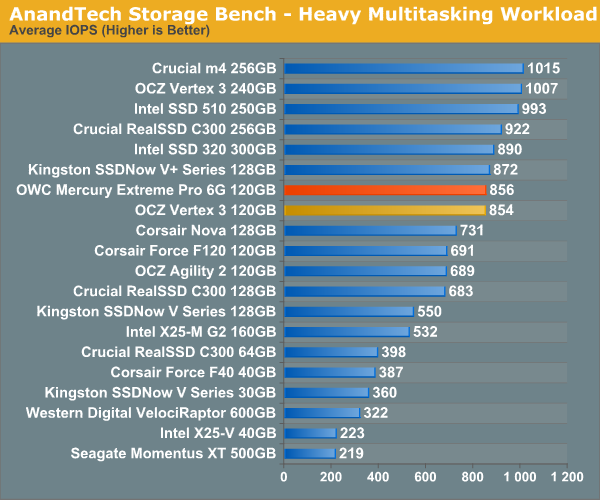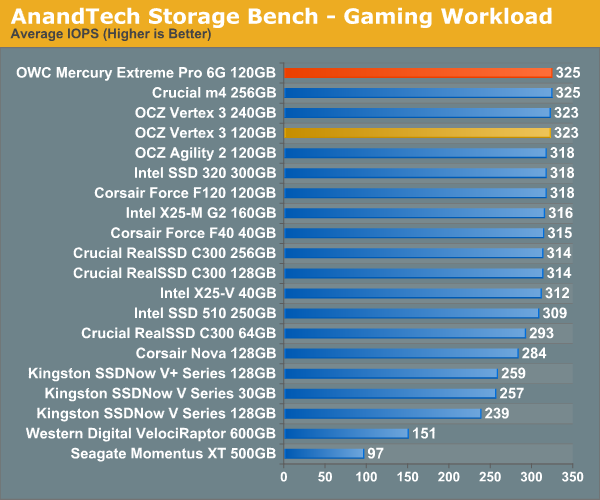OWC Mercury Extreme Pro 6G SSD Review (120GB)
by Anand Lal Shimpi on May 5, 2011 1:45 AM ESTAnandTech Storage Bench 2010
To keep things consistent we've also included our older Storage Bench. Note that the old storage test system doesn't have a SATA 6Gbps controller, so we only have one result for the 6Gbps drives.
The first in our benchmark suite is a light/typical usage case. The Windows 7 system is loaded with Firefox, Office 2007 and Adobe Reader among other applications. With Firefox we browse web pages like Facebook, AnandTech, Digg and other sites. Outlook is also running and we use it to check emails, create and send a message with a PDF attachment. Adobe Reader is used to view some PDFs. Excel 2007 is used to create a spreadsheet, graphs and save the document. The same goes for Word 2007. We open and step through a presentation in PowerPoint 2007 received as an email attachment before saving it to the desktop. Finally we watch a bit of a Firefly episode in Windows Media Player 11.
There’s some level of multitasking going on here but it’s not unreasonable by any means. Generally the application tasks proceed linearly, with the exception of things like web browsing which may happen in between one of the other tasks.
The recording is played back on all of our drives here today. Remember that we’re isolating disk performance, all we’re doing is playing back every single disk access that happened in that ~5 minute period of usage. The light workload is composed of 37,501 reads and 20,268 writes. Over 30% of the IOs are 4KB, 11% are 16KB, 22% are 32KB and approximately 13% are 64KB in size. Less than 30% of the operations are absolutely sequential in nature. Average queue depth is 6.09 IOs.
The performance results are reported in average I/O Operations per Second (IOPS):

If there’s a light usage case there’s bound to be a heavy one. In this test we have Microsoft Security Essentials running in the background with real time virus scanning enabled. We also perform a quick scan in the middle of the test. Firefox, Outlook, Excel, Word and Powerpoint are all used the same as they were in the light test. We add Photoshop CS4 to the mix, opening a bunch of 12MP images, editing them, then saving them as highly compressed JPGs for web publishing. Windows 7’s picture viewer is used to view a bunch of pictures on the hard drive. We use 7-zip to create and extract .7z archives. Downloading is also prominently featured in our heavy test; we download large files from the Internet during portions of the benchmark, as well as use uTorrent to grab a couple of torrents. Some of the applications in use are installed during the benchmark, Windows updates are also installed. Towards the end of the test we launch World of Warcraft, play for a few minutes, then delete the folder. This test also takes into account all of the disk accesses that happen while the OS is booting.
The benchmark is 22 minutes long and it consists of 128,895 read operations and 72,411 write operations. Roughly 44% of all IOs were sequential. Approximately 30% of all accesses were 4KB in size, 12% were 16KB in size, 14% were 32KB and 20% were 64KB. Average queue depth was 3.59.

The gaming workload is made up of 75,206 read operations and only 4,592 write operations. Only 20% of the accesses are 4KB in size, nearly 40% are 64KB and 20% are 32KB. A whopping 69% of the IOs are sequential, meaning this is predominantly a sequential read benchmark. The average queue depth is 7.76 IOs.











44 Comments
View All Comments
Concillian - Thursday, May 5, 2011 - link
This is why I won't buy a SandForce SSD. Yeah, I can get a brand that doesn't have a cap. Or I can go with a different SSD that doesn't force me to jump through hoops to make sure I'm the same hardware from the right vendor.
The same hardware from different vendors should not have vastly different performance. How many people would put up with a memory bandwidth limit on P67 chipset motherboards from Gigabyte, but not ASUS? (or whatever brands.) No memory bandwidth doesn't have a huge impact on overall PC performance, but I think it would still be a big deal if something like that actually happened.
The SF-2281 either needs all vendors capped or none. It's a really shady tactic to offer two versions of the same hardware IMO.
semo - Thursday, May 5, 2011 - link
Nobody in the know likes the SF games but the whole thing is so complicated that most people won't understand it. Suits OCZ as the recent bad publicity doesn't seem to have affected them and everyone thinks they are the best choice for SSDs.Where are the Corsair force GT drives? Also, why are there no reviews of the Samsung 470?
Mr Perfect - Thursday, May 5, 2011 - link
I agree. If you want to offer vendors special products, fine, but give them a different model number. Call a controller capable of 27k a 2280 and the 52k version the 2281. You can still have incentive products, but the consumer doesn't get duped. Everyone's happy.Flunk - Thursday, May 5, 2011 - link
Almost all IC vendors do this. Intel is probably the worst by far. Selling essentially the same chip up to 50 different ways but lasering off parts of it. Almost all onboard sound chips, network chips, drive controllers, GPUs and anything else you can think of uses the same strategy.Chloiber - Thursday, May 5, 2011 - link
So the huge IOPS are pretty much useless, if the QD needs to be high - which is the case with every SSD.Anand, how is the "burst" rate of the Mercury regarding Random Write IOPS? I remember that with SF 12xx, the burst rate was exactly the same (for some seconds), only after 5-20s you could see a difference between the "unlocked" Vertex 2 and the rest. Considering how often one needs the random write performance for several seconds or even minutes (= never) I still think those huge IOPS numbers and the "unlocked firmware" stuff are just a huge marketing stunt. The benefit for the "normal" home user is = zero.
semo - Thursday, May 5, 2011 - link
Why is a high IOPS figure useless? Just because average Joe facebook doesn't do continuous IO intensive operations doesn't mean we don't need fast SSDs. You can apply your "logic" to CPU, GPU and pretty much any other technological advancement.kmmatney - Thursday, May 5, 2011 - link
For the normal home user, the Anand light workload test is really the best thing to look at - no need to look at any other metric. The drive does really well here.Robear - Thursday, May 5, 2011 - link
I believe most people who are interested in the power consumption are most interested in how it performs in a notebook. 2W versus 7W in power is negligible on a desktop. Instead of using a Velociraptor, can you please compare the SSD to a notebook hard drive, like maybe a Seagate Momentus?krazyderek - Thursday, May 5, 2011 - link
the momentus XT is included, the XT was a little more power hungry then typical notebook drives, have a look at the past review for more info to comparehttp://www.anandtech.com/show/3734/seagates-moment...
looks like some the new round of SSD's forgo power savings to move up the performance latter (ie: 240gb OCZ V3)
mschira - Thursday, May 5, 2011 - link
I was wondering if one could fit this drive into a 7mm slimline slot such as the Lenovo T420s.Lenovo only offers an Intel 160gb drive but I would fancy the possibility to insert a speedier 240gb SSD. maybe when removing some of the casing?
cheers
M.